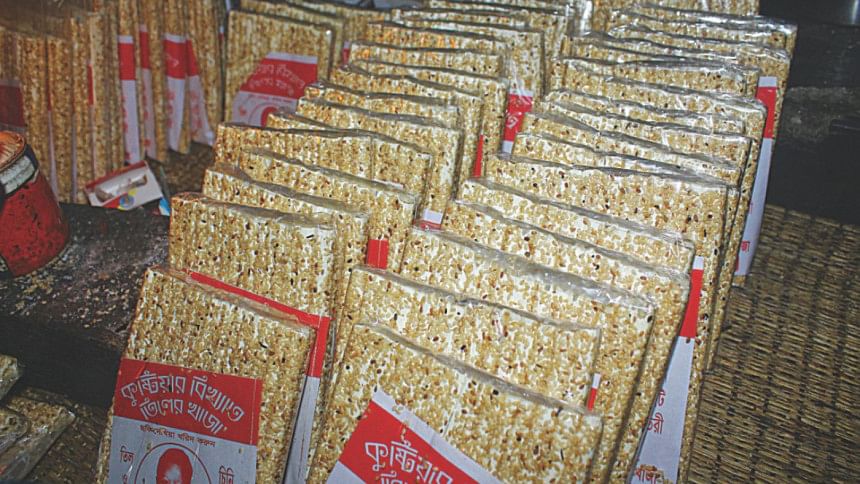Khaja: Kushtia's mouth-watering sweet

Aside from Lalon Shah, one would be hard-pressed to find anything that says 'Kushtia' in quite the way tiler khaja does. A perennial favourite that is often sold by street hawkers at ferry ghats, bus and railway stations, as well as at fairs and festivals, this iconic, ubiquitous sesame sweet has achieved nationwide renown. It'd be difficult to find a person who has never tried a piece, inevitably to experience that sensation of a satisfied, Kushtia smile.
The precise origins of tiler khaja are lost to time; but Kushtia locals believe the item was first produced from around 1900 in an undivided India. Some point to the Teli, a caste community traditionally employed in pressing oil, as the sweet's inventors. Members of that community were first brought to Kushtia by the British East India Company to work on a farm.
The earliest tiler khaja factories are probably those which were established in the Deswalipara area of Kushtia town, nearby the economically vibrant Kushtia Mohini Mills. From there, the sweet's popularity only gained ground, across the district, into adjacent districts and ultimately, nationwide.
In Kushtia district today, up to eight factories, for the most part household-sized family concerns, produce as much as 250 kilograms of tiler khaja daily, to satisfy orders from near and far.
Dulal Seikh, 52, who has been involved in making tiler khaja for the last 35 years, leads a nocturnal sort of a life. At midnight he is to be found boiling sugar, adding the other key ingredients of flour and sesame as required. “We always work at night,” he says. “In the daytime we're free.”

For Dulal, tiler khaja manufacture is an ancestral profession, learnt from his grandfather Adhor Seikh who was making the sweet at least 65 years ago. “The item has enduring popularity,” Dulal says. “I feel so proud when I see our sweet being sold across the country.”
“Nowadays tiler khaja is also made in other places including Rajbari, Khulna and Dhaka,” he continues, “but most of the workers in those factories are also from Kushtia. Their product is still marketed using Kushtia's name.”
Alongside its delectability, tiler khaja is also popular for its low price. A 100-gram piece retails for around Tk 10, a price that has become more difficult to maintain given the recent rise in the price of sesame. “We used to buy forty kilograms of sesame for around Tk 1,200,” notes Dulal. “Now it costs as much as Tk 2,700.” While tiler khaja is enjoyed around the country, it is quite naturally at home in Kushtia where the sweet means the most. “Whenever I hear hawkers call out 'Ei je khaja! Kushtia tiler khaja!' I feel so nostalgic for my childhood,” says Kushtia social worker Ashrazuzzaman Nazu, 66. “I've eaten this sweet through the whole of my life. When I chew a piece I feel quite enchanted.”
One thing that's for sure is that Ashrazuzzaman is not alone among Kushtia's public in feeling a special loyalty to the district's own distinctive sweet.

 For all latest news, follow The Daily Star's Google News channel.
For all latest news, follow The Daily Star's Google News channel. 



Comments